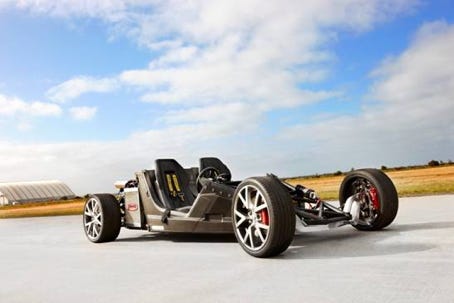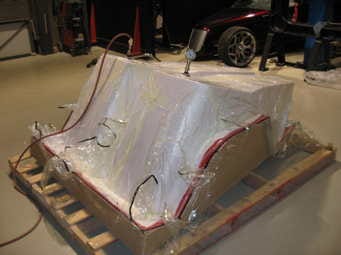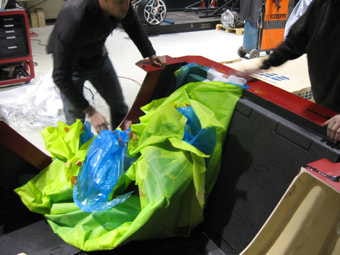After nine years and over A$1 million invested, the Australian-designed-and-built FR-1 has become a reality. The one-off, high-performance, concept roadster features a monocoque cockpit chassis molded "out-of-autoclave" at a temperature of only 70°C using an epoxy prepreg with a 200 g/m2, 3k twill carbon-fiber base fabric.
May 3, 2012
After nine years and over A$1 million invested, the Australian-designed-and-built FR-1 has become a reality. The one-off, high-performance, concept roadster features a monocoque cockpit chassis molded "out-of-autoclave" at a temperature of only 70°C using an epoxy prepreg with a 200 g/m2, 3k twill carbon-fiber base fabric.
|
Lightweight sports car relies heavily on carbon-fiber monocoque. |
|
Out-of-autoclave molding saves part manufacturing costs in multiples. |
|
Monocoque is demolded. |
The epoxy carbon cockpit chassis, with approximate dimensions of 2m by 1.5m, weighs only 80 kg but still provides the high torsional rigidity needed. This has been achieved by design optimization in the number and orientation of the carbon fiber plies used. The high mechanical performance of the fabricated chassis laminate has been independently tested, correlated and analysed using FEA analysis, by the Australia Future Fibres Research & Innovation Centre (AFFRIC) at the Deakin University of Melbourne.
The FR-1 concept car project is run by a charitable foundation called AutoHorizon whose aims are to demonstrate the engineering, design, and manufacturing expertise available in Australia today and to inspire Australian school and college students to become the engineers and designers of the future. The FR-1 project has over 90 sponsors including: the Victorian Centre for Advanced Materials Manufacturing (VCAMM); local automaker Holden; Boeing Aerostructures Australia, the Automotive Centre of Excellence (ACE) in Melbourne, where the concept car was built, and GMS Composites (Melbourne, Australia), who manufactured and supplied the GMS EP270 carbon-fiber prepreg system for the FR-1 project.
The VCAMM/AutoHorizon/Boeing engineering team which worked on the FR-1 project designed and built the FRP cockpit chassis and the fiberglass mold tooling. They considered a number of different epoxy prepreg options; GMS EP270 was selected due to a combination of several critical factors. First, as the vehicle is a one-off, they were looking for a cost-efficient, low-temperature tooling and production process using a material they could obtain in small volumes. Second, they needed a material, which, post-curing, would provide the required dynamic strength and stiffness properties in the monocoque cockpit chassis needed for a sports car powered by a Holden 6.0 litre V8 with a Ferrari 355 transmission. GMS EP270 with a carbon-fiber fabric fit the bill perfectly, being a high-performance, out-of-autoclave epoxy resin prepreg designed for low-temperature molding under vacuum at as low as 70°C, using fiberglass tooling.
GMS Composites has the manufacturing flexibility to supply even small volumes of the GMS EP270 prepreg system in a choice of carbon fiber, aramid or glass-fiber reinforcements. In addition to being used for molded FRP parts, GMS EP270 can also be used in the construction of composite sandwich structures as well as for tooling applications.
Having completed the design and material specification phase and built the mould tooling, the FR-1 project team then used the production expertise of Boeing Aerostructures in Port Melbourne to assist with layup, molding and fully curing the GMS EP270 carbon fibre prepreg, as well as bonding the chassis using an aerospace-grade, high-performance Araldite structural adhesive. Jason Bonar, who has been with Boeing for over 18 years, worked with the AutoHorizon team on the molding and lay up of the chassis, which included eight, 16-hour cure phases and a final post-cure, all of which were done out of autoclave, under vacuum, at 70°C.
During production, GMS EP270 prepreg offered the benefits of being very easy to work with, conforming accurately to the tight and detailed tool, and realizing a final product with outstanding finish and integrity. Bonar commented: "With respect to workability and surface finish, I found GMS EP270 prepreg to be on par, if not better, than any other prepregs I have used."
For some years now, in order to drive down capital and operating costs, as well as to gain greater production efficiency and flexibility, many leading OEM and Tier 1 manufacturing companies in the aerospace industry have now approved and specified a number of primary and secondary structural composites parts manufactured from an out-of-autoclave composite prepreg material; out-of-autoclave prepregs have the added benefit of simpler and significantly lower tooling costs. While exact figures are not divulged by Boeing Aerostructures, out-of-autoclave, composite-part manufacturing costs are estimated to be a factor of four times lower, with tooling costs typically reduced by over 50%. —[email protected]
About the Author(s)
You May Also Like





